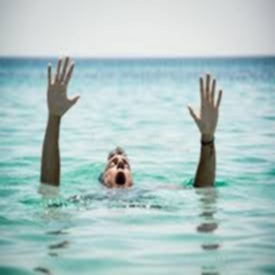In Short
All I can recall is that I felt as though I was gazing through a beautiful kaleidoscope of colors. I started to unwind after realizing that nobody could save me. I was unable and unwilling to move. Wow, this is a dumb way to pass away, I thought. What comes next, I wonder? And it seems like I lost all feeling the instant I relaxed. It was similar to meditation.
On that particular day, I woke up gloomy. The weather wasn’t pleasant either. Dark clouds hung precariously in the atmosphere, occasionally blocking the sun, making the temperatures somehow chilly. With no particular plans for the day, I found myself bored and undecided about what to do. Time dragged by slowly. Everything was disinteresting, including the games I usually played with my siblings. It was about two when a group of friends happened to pass by our gate and convinced me to go with them to the river.
The River of Dead Bodies
It was always our habit to spend the usually scorchy afternoons swimming in the gushy waters of what had come to be named the River of Dead Bodies. The name came along after numerous bodies of murder victims were recovered from the river. I was a great swimmer. My peers knew that, so I always took the first dive. But on that particular day, I was reluctant, and one of the other guys plunged into the murky waters. I watched him swiftly swim among the waves and bubbles, spraying water with his feet as he went out the other bank. I then dove.
At first, I was just swimming very well with the usually powerful kicks that propelled me. Then somewhere midway, I felt my body grow feeble. I began running out of breath and then my legs couldn’t pump anymore. I felt the powerful waters carry my weak body. Though I was lucky not to be dragged into the rapids, I was unfortunate enough to get myself trapped in a whirlpool over the deepest part of the riverbed.
Drowning, Keeping The Airway Clear of Water
My friends saw my first attempts to stay afloat as my usual jokes, mimicking a drowning person. It took some more time before the gravity of the situation dawned on them, and one of them swam quickly towards me. In my state of despair, I quickly grabbed him, in the process making him unable to swim since I was far heavier than him. Realizing it could just worsen the situation, I pushed him away.
READ ALSO: Psychological Health: Accepting Negative Emotions
During the few seconds I had clung to him, I had drawn in some air. At that time, my legs had completely given way so I let myself sink. I could hear my younger brother’s shrieks of despair till the water covered my ears. Far below the surface, I let my hands wander. I held my breath tightly. Then my right hand grabbed something. It was a bit slimy due to the plankton sprouting on it but firm enough to save me. A rock stool, sprouting from the horrific depths of the river bed to just the level that I could stand on it and get my head above the waters. That saved me.
Drowning, Statistics
Drowning is a major cause of unintentional fatality worldwide and is frequently mentioned in court proceedings. In these situations, establishing the amount of compensation and the final result frequently depends heavily on potential mitigations as well as the “pain and suffering” related to the length and subjective experience of drowning. Understanding the phases of the drowning process as well as the length of time and the physiological and subjective reactions connected to each stage is therefore necessary.
READ ALSO: An Ancient Curse? Menstruation In Female Humans
Drowning Starts With The Battle to Keep Water Out of the Airway
This phase could not exist in circumstances when individuals are forced to be submerged (such as in a sinking boat or an inverted helicopter ditch). In those who are unable to swim, it could also be rather brief, lasting 20 to 60 seconds. This stage won’t begin until swim failure occurs in cases when people can swim at first. This might take hours in warm water and be linked to fatigue in this case. Even proficient swimmers may experience swim failure in as little as ten minutes in cold water. This is because of chilling and the inability of superficial muscles and nerves to function. Swim stroke length decreases and stroke frequency rises in this situation, indicating a definite move towards swim failure. With time, the person gets more erect in the water, and “swimming” turns into “treading water.” This is usually associated with alternating periods of submersion and floating.
Drowning, This Battle Usually Goes Unnoticed
Subtle and frequently undetectable is the change from swimming to fighting to keep the airway clear of the water. The “Instinctive Drowning Response” (IDR) idea (no yelling or waving for aid, airway repeatedly submerged, upright body, horizontal arm motions merely underwater) was described using real-situation film footage. The most commonly used definition of drowning behavior that is apparent is the IDR. The conclusion was that drowning victims can only battle on the water’s surface for 20 to 60 seconds before going under. This is in line with how long a person can typically work hard anaerobically before becoming exhausted.
Drowning: What The Rescue Must Know
It is determined that when a person is unable to swim, they strain to keep their airway free of the water. In the process they exhibit certain behaviors that rescuers should be aware of. This period is unlikely to endure more than 60 to 90 seconds, even if the person is not forcibly submerged.
Drowning, Initial Holding of Breathe
Factors such as water temperature, clothing worn, activity, training, aerobic fitness, and experience will all affect the breath-hold time after submersion, or when the airway descends below the water’s surface. Significant inter-individual variation exists as well.
How Drowning Might Cause Unnoticed Cardiac Death
The involuntary gasping that occurs at the breath-holding breakpoint causes aspiration of water if the airway is submerged. As previously mentioned, a gasp response that can be 2–3L in volume—that is, larger than the documented deadly amount of aspiration for drowning—significantly reduces breath-holding upon immersion in cold water. The combination of stopping the breathhold and submerging the face in cold water can also cause dangerous cardiac arrhythmias and rapid cardiac death. Because a disruption in the heart’s electrical conductivity cannot be detected and agonal gasping might produce water aspiration and the appearance of drowning, this cause of death might go unnoticed at post-mortem.
READ ALSO: Preteen Parenting: Ten Items Preteen Girls Require from Their Mother
Aspiration of Water
Approximately 89% of drowning victims swallow water near the end of breath-holding before the water is aspirated into their lungs. Reflex swallowing, which is frequently exacerbated by the cough reflex, can result from water entering the pharynx. Water stimulation of the oropharyngeal and laryngeal innervated mucosa can result in transient laryngospasm or bronchospasm. It appears improbable, nevertheless, that this condition will continue until death (what was formerly referred to as “dry drowning”). The increased rate of vomiting in drowning victims could be explained by water swallowing. Water enters the lung during and after swallowing, and the larynx gradually relaxes due to hypoxia, allowing water to be aspirated.
Drowning, Unconsciousness
Hypoxia, hypoxemia, and anoxia worsen with time due to the disruption of gas exchange and the depletion of surfactant brought on by the presence of water in the terminal airways. Brain energy supplies are being depleted, brain energy metabolism is failing, brain function deteriorates, unconsciousness occurs, and permanent neuronal cell damage occurs.
Cardio-Respiratory, Arrest
During this stage, there was apnea or irregular breathing, and the blood pressure was marked by slow, “vagal-like” beats. from the sharp decline in blood pressure to the point where it was zero. This happened 262 seconds after submersion on average (the range for 95% of instances was 134 to 360 seconds). During this phase and occasionally when blood pressure drops to zero, terminal gasps happen.
Drowning, Death
According to the literature, the sooner a drowning person is pulled from the water and oxygenation and basic life support are started, the better their chances are. Numerous publications have linked a better result to submersion times of less than five to ten minutes. Children or small adults who survive extended submersion typically do so because of their relatively high surface area to mass ratio. This causes them to dissipate heat from their bodies more quickly after the respiratory cooling period.
Why do Dead Bodies Float on Water, But People Sink When Drowning?
When a person is living, their body density is determined by various factors. Examples are the amount of air in their lungs or the amount of body fat they contain. If you’ve learned to swim, you might think about trying to learn how to float as well. Depending on their body composition, some people find it simpler than others. When a person passes away, their “density” surpasses that of water, causing them to sink once the air has left their lungs. Very tiny “animals” known as microbes eventually begin to consume parts of the body, which results in a large amount of gas. Because the gas is light, the body’s density then drops once more, indicating that the body will float.



